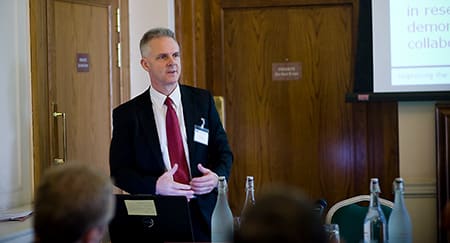Could engineering hold the solutions to the growing storm of more people, increased climate change and greater food and water stress?
This century the world will come face to face with the results of the biggest population explosion in human history.
Without taking action now, billions of people across the world will face thirst, hunger, slum conditions and conflict
Imagine two billion additional people on the planet within 40 years, all needing food, water and shelter, with climate change stressing those basic human needs.
Without taking action now, billions of people across the world will face thirst, hunger, slum conditions and conflict in response to droughts, food shortages, urban squalor, migration and ever depleting natural resources, while capacity tries to catch up with demand.
And the projected growth in demand is staggering. More mouths to feed and changes in tastes for food types will mean:
- doubling agricultural production in four decades,
- water consumption will need a 30% increase by 2030, and
- three billion extra people will seek shelter in urban settings by mid-century.
Add to this the need for energy to underpin economic growth in post-industrial, industrial and newly industrialising nations alike, with demand doubling by 2050, and there is a significant challenge for governments and society at large.
The good news is that a recent report, entitled “Population: One Planet, Too many People?” by the UK Institution of Mechanical Engineers found that anticipated challenges could be met with known engineering technologies and sustainable practice. The implication being that there is no need to delay global action while waiting for the next major technical discovery or a breakthrough in thinking on population control.
The population of the world is projected to increase in the coming decades to reach 9 billion people in 40 years (from today’s 6.9 billion) and attain a peak of 9.5 billion in 2075
The report also concluded that we are on the cusp of a unique opportunity, with an abundance of clean technologies and know-how available to enable newly developing nations to ‘leapfrog’ the high emissions, resource hungry phase of early industrialisation. This is particularly important, as it is within these emerging economies that the greatest population increases are expected to occur.
Overall, the population of the world is projected to increase in the coming decades to reach 9 billion people in 40 years (from today’s 6.9 billion) and attain a peak of 9.5 billion in 2075. These headline figures do not however reveal important regional demographic trends which show the emergence in the coming decades of three classifications into which the characteristics of most nations will fall.
- Mature post-industrial economies will be characterised largely by stable or declining populations. For example, the number of people in the European Union is projected to decrease by 20% over the period to 2100. The accompanying decline in young people will have wide ranging implications for issues of social care, healthcare and workforce composition. Population-driven conflict and climate change-induced stresses overseas will also impact these economies, through disrupted supply chains for agricultural produce and manufactured goods.
2) Late-stage developing economies, currently characterised by high levels of industrialisation, will experience decelerating population growth as domestic affluence increases. For example in Asia, which already has half the world’s population, the number of people is projected to increase by only 25% to a peak in 2065 before declining in a similar mode to some post-industrial economies. Although modest, the continued increase over the next five decades in the population of this region, coupled with high levels of growth in personal income and wealth, will likely lead to geopolitical tension between individual nations over natural resources such as shared water sources and raw materials for industry.
3) Newly developing and as yet undeveloped economies on the verge of industrialisation form the third grouping. Accelerating population growth, accounting for the majority of the global increase through to 2075, is the key characteristic of these nations. Africa is the principle area in this regard, with many of the continent’s countries projected to double or triple their populations by 2050. This will result in considerable pressure for increased domestic food production, water abstraction and access to energy. When combined with social and political tension from uncontrolled urbanisation and a dramatic expansion of slums, domestic and cross-border conflict could result, destabilising international trading routes and driving migration away from areas of conflict to more stable regions such as Europe.
Geopolitical tensions between nations in all three of these groups are likely to arise over both fossil fuel (coal, oil and gas) and low-carbon sources of energy. Access to affordable and abundant energy underpins industrialisation, the rise out of poverty, economic growth and post-industrial society.
A new world order will take shape as nations emerge rich in newly exploitable resources, such as solar in North Africa, and others who dominated 20th century energy supply struggle to maintain wealth and influence
History teaches us repeatedly that without this energy, societies ultimately collapse in the face of diminishing returns on investments in higher levels of complexity. A new world order will take shape as nations emerge rich in newly exploitable resources, such as solar in North Africa, and others who dominated 20th century energy supply struggle to maintain wealth and influence.
We found newly developing economies to be critical to a successful outcome. If these nations set off on the same high greenhouse gas (GHG) emitting, unsustainable development trajectory followed in the past by the mature industrialised nations of the world, the result will be uncomfortable for us all.
For example, if through a combination of industrialisation and economic growth during the 21st century the average GHG footprint of Africans attains the modest level of Asians today, the newly enlarged population of this continent would be adding around 9Gigatonnes/year of greenhouse gases to the atmosphere. That’s 1/4 of current global emissions. In a world where we are struggling to decrease emissions from a legacy of unsustainable industrial infrastructure, such an outcome would be tragic and unforgivable, particularly as we have the know-how and clean technologies available today to avoid it.
Through the application of engineering solutions such as biotechnology, increased mechanisation and automation, waste reduction, improved storage and distribution and better water management, more than enough food can be provided to meet the anticipated demand.
Similarly, improvements in groundwater management, storm water capture and storage, water recycling and desalination can match future consumption.
In the urban environment, integrated planning and novel community ownership models offer a route to successful slum infrastructure interventions. One third of the world’s urban population already lives in appalling slum conditions with little or no access to clean water, sanitation or energy infrastructure.
Engineering solutions could also play a key role in addressing the threat of rising sea levels to urban areas. Three quarters of the world’s large cities are on the coast and some of the biggest are based on deltaic plains in developing countries (such as Bangkok and Shanghai) where land subsidence will exacerbate the challenge. Given the long lead times in implementing strategies such as engineered flood defence infrastructure, assessment of the projected rises and potential solutions needs urgent attention in coastal settlements around the world.
Innovative approaches to finance will play an important role not just in engineering approaches to urbanisation but also in the deployment of community-based clean energy technologies, such as solar, wind and micro-hydro together with localised combined heat and power plant using biomass or energy from waste. If significant levels of access to energy and water are to be realised and adoption of localised sustainable technologies encouraged, mechanisms such as innovative soft loans and micro-financing, ‘zero-cost’ transition packages and new models of personal and community ownership, such as trusts, must be put in place to reduce the capital investment.
It is difficult to predict exactly what climate changes will occur in any particular region as a result of a possible 3°C to 6°C of global warming by the end of the century. There may be some areas, particularly in the Northern Hemisphere, where the effects of climate change increase a nation’s capability to cope with population growth, such as through increased agricultural yields or easier access to energy. However the effects of extreme weather events, increased temperatures and shifting rainfall patterns will result in other areas having difficulty coping with higher numbers.
Evidence shows that sustainable engineering solutions largely exist to meet many of the challenges anticipated from population growth and for mitigation of climate change stress
Projections suggest that up to one billion people could be displaced by climate change in the next 40 years, through an intensification of natural disasters, drought, rising sea-levels and conflict over increasingly scarce resources. Large-scale migration away from such areas, placing even more pressure on the regions of the world that emerge from climate change as temperate, could bring significant security concerns to the more fortunate nations.
Evidence shows that sustainable engineering solutions largely exist to meet many of the challenges anticipated from population growth and for mitigation of climate change stress. For example, the deployment of energy management technologies, such as intelligent appliances and smart meters, together with reductions in waste through better-insulated buildings and effective use of heat, are examples of engineering initiatives which could alleviate some of the impacts of needing more sustainable energy sources.
What is needed is political and social will to correct market failures, provide innovative financing mechanisms and novel models of personal and community ownership, and transfer clean technology and best practice knowledge through localisation to achieve a more secure outcome.
The Institution’s report has proposed five engineering development goals (EDGs) as a first step on the path to achieving such an aim. These cover the key issues to be tackled in energy, water, food, urbanisation and finance.
Further it calls on the UK Government to take a global lead on working with the profession to define delivery targets and performance metrics for implementation of these EDGs with a view to championing them at the UN, as the basis of an international framework to supersede the Millennium Development Goals (MDGs) when they expire in 2015.
In support of the goals, the Institution has also recommended that a mechanism be adopted for the training and secondment of engineers into newly developing nations to provide advice on localisation of clean technologies and sustainable practice. Indeed, it has called on the UK Government’s Department for International Development (DFID) to take the lead on pioneering a secondment model as part of its overseas development remit.
In summary, with more of us living longer in mutual dependence on an increasingly crowded planet of finite resources, the effects of global population increase will be felt to some degree in everyone’s life - wherever they live. The impact will not respect borders. This is not altruism. This is about creating a policy framework and implementing a pathway for self-defence.




